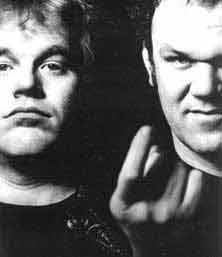Hollywood has had its shares of “The Making Of” specials in the past few years. Most major box office smashes have follow-up videos about how they were made. Lost in La Mancha was supposed to be another one of these promotional specials, but ended up being an interesting documentary on the complete failure of a film.
Filmmakers Keith Fulton and Louis Pepe follow the making of The Man Who Killed Don Quixote, Terry Gilliam’s pet project. Gilliam, known for directing unconventional, mind-bending films such as Brazil, Twelve Monkeys, and Fear and Loathing in Las Vegas, wants badly to create the tale of the famous Spanish character. He enlists French actor Jean Rochefort to play the main role, and Johnny Depp as a variation on sidekick Sancho Panza.
The filmmakers track Gilliam as he oversees the pre-production of the film. Gilliam’s delight with the film is obvious as he looks at costumes, storyboards the action, and finds actors to portray ogres. His project runs smoothly, even though he and his producers admit that they are on a tight budget. This documentary shows that films shot outside the Hollywood system have to be careful about their expenses. It is a prime lesson of the film.
When the actual shooting of The Man Who Killed Don Quixote begins, all sorts of problems pop up. Rochefort develops a kidney stone that will not allow him to be on a horse, which is crucial for many of his scenes. This delay hurts the film’s progress, and Gilliam and his assistant struggle to reorganize their schedule.
More problems occur during the shooting when heavy rain changes the scenic desert into a mud pit. Not only that, but Gilliam must deal with planes flying overhead more often than had been planned. All of these problems, plus more, ultimately lead up to the film being called off.
Fulton and Pepe do a masterful job of capturing the emotions and opinions of everyone involved. Gilliam’s disappointment at the end is so obvious, as is that of his producers and crew. This is in stunning contrast to their idealistic, excited mood in the beginning. The filmmakers take us behind the scenes to see the various conflicts that go on between production members. There is also a short segment that explains Gilliam’s history and the characteristics of his films.
This film shows all the things that can go wrong with filmmaking. Some of the problems could be due to a lack of planning, but many of them are stranger acts of circumstance. A sufficient blow comes when one of Gilliam’s producers admits that he does not have all the money he said he had.
It is fortunate to the filmmakers that everyone responds with such honesty and insight. Gilliam happily lets them into his working world, even when the film is going to hell. Jeff Bridges, who worked with Gilliam in The Fisher King, ably narrates the documentary with an even tone.
In the end, this film shows a whimsical project that could have been- and possibly still might be. Gilliam, ever the idealist (another main point of the film), discloses in a late segment that he plans to buy back the rights to this film and finish it someday.
This documentary gives a real look to filmmaking, not like those aforementioned “Making Of” promos. The lessons learned in the filming of Gilliam’s project are sad, but helpful to any potential filmmaker.
